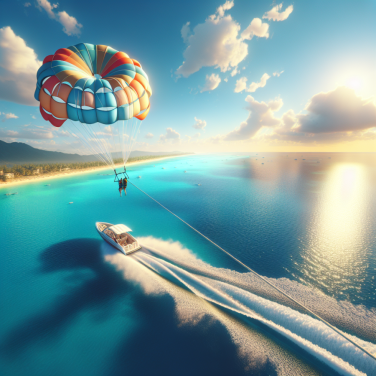Maximizing Your Parasailing Experience: Techniques and Locations to Explore
Maximizing your parasailing experience involves a combination of proper technique as well as choosing exciting locations that enhance the overall adventure. When it comes to technique, it's all about understanding the process and what you can do before and during your flight to make it as enjoyable as possible.
**Before taking off**, it's essential to get a full briefing from your instructor. Listen carefully and ask questions if anything is unclear. Make sure you're comfortable with the harness and that all of your gear is secure. Consider the weather conditions too; ideal parasailing weather is a sunny day with moderate winds.
**As you take off**, you'll want to stay relaxed. Keep your legs straight and allow the boat to pull you up smoothly. Avoid jumping or making sudden movements as that can cause instability. Trust the equipment and the crew; remember that the harness will support you comfortably if you lean back and enjoy the ride.
**While you're in the air**, remember to breathe and take in the scenery. It might be tempting to focus on the feeling of flying or on any anxieties you have, but the beauty of parasailing is also in the panoramic views it provides. Depending on the location, you could be treated to sights of clear blue waters, expansive beaches, or even marine wildlife below.
**As for steering**, basic control of your direction can be achieved by pulling down on the 'steering bars' or toggles. This can help you rotate or change direction slightly, but remember that your primary direction and speed are controlled by the boat below.
**Landing** is often the trickiest part for first-timers. Follow the crew's instructions for a smooth descent. Typically, they will direct you to either lift your legs for a beach landing or to prepare to be reeled back onto the boat.
When it comes to **locations**, there are some incredible spots around the world known for their exceptional parasailing experiences. Here are a few notable ones:
- **Maui, Hawaii**: With its pristine waters and the backdrop of the West Maui mountains, parasailing here is a breathtaking experience.
- **Cancun, Mexico**: Offering some of the most beautiful waters of the Caribbean, Cancun provides a stunning setting for parasailers.
- **Gold Coast, Australia**: For those down under, the combination of city skyline and expansive ocean views makes for an unparalleled flight.
Read also:
Mastering the Art of Discus Throw: Techniques and Tips
Preparing for Your Parasailing Journey: Safety Tips and Essential Gear
To ensure you have an amazing parasailing experience, being well-prepared is key. This section will focus on the safety measures and necessary equipment for your journey into the skies.
**Safety Tips for Parasailing**
- **Check Operator Credentials:** Before you book your parasailing adventure, do thorough research on your chosen operator. Ensure they have a strong safety record and positive reviews. They should be licensed and adhere to the regulations set by governing bodies, such as the Federal Aviation Administration (FAA) or the local equivalent in your country.
- **Listen to the Briefing:** Pay close attention to the pre-flight safety briefing. This will cover essential information such as hand signals, landing procedures, and what to do in an emergency. It is vital to understand this information before you are up in the air.
- **Weather Watch:** Weather plays a pivotal role in parasailing safety. Only go parasailing when the weather conditions are favorable—no storms, strong winds, or approaching fronts. Check the forecast ahead of time and do not hesitate to reschedule if the weather looks uncertain.
- **Use a Life Jacket:** Regardless of your swimming skills, wearing a life jacket is compulsory. It provides buoyancy if you land in the water and is a critical safety tool in case of an unexpected dip.
- **Harness Check:** Your harness is your link to the parasail. Ensure that it is properly fitted and secured before takeoff. Double-check that all the straps are tight and that you feel comfortable and secure.
- **Avoid Overloading:** Never exceed the weight limit specified by the parasailing operator. Overloading the parachute can make it unstable and difficult to control.
- **Know the Altitude Limits:** There are height restrictions for a reason. Ascending too high increases the risks, especially if weather conditions change rapidly.
- **Communication is Key:** Always maintain a way to communicate with the boat operator. Whether it's using hand signals or another agreed-upon method, you need to be able to convey any issues immediately.
**Essential Gear for Parasailing**
- **Appropriate Clothing:** Wear comfortable, secure clothing that won't restrict your movement. Avoid loose articles that can be lost or become hazardous while airborne. A bathing suit is often recommended, as you may get wet from the spray or during dips.
- **Safety Helmet:** Though not always required, wearing a helmet can provide an extra layer of safety, protecting your head in the unlikely event of an impact with the water or harness.




